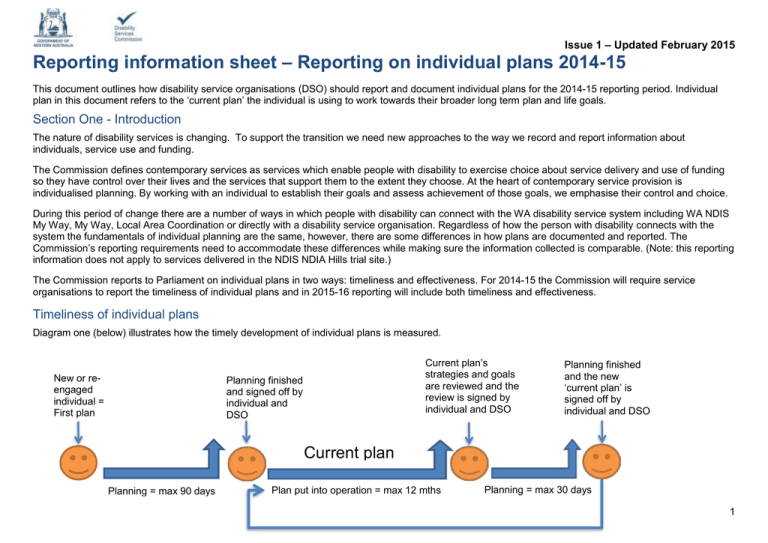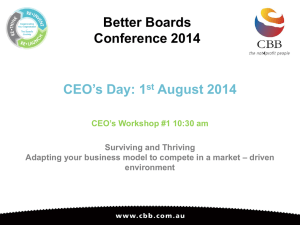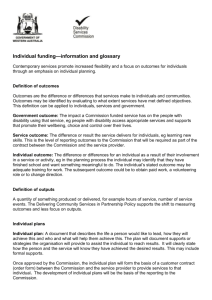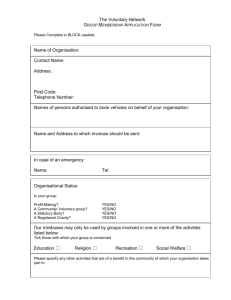Reporting newsletter - Issue 1 (updated February 2015)
advertisement

Issue 1 – Updated February 2015 Reporting information sheet – Reporting on individual plans 2014-15 This document outlines how disability service organisations (DSO) should report and document individual plans for the 2014-15 reporting period. Individual plan in this document refers to the ‘current plan’ the individual is using to work towards their broader long term plan and life goals. Section One - Introduction The nature of disability services is changing. To support the transition we need new approaches to the way we record and report information about individuals, service use and funding. The Commission defines contemporary services as services which enable people with disability to exercise choice about service delivery and use of funding so they have control over their lives and the services that support them to the extent they choose. At the heart of contemporary service provision is individualised planning. By working with an individual to establish their goals and assess achievement of those goals, we emphasise their control and choice. During this period of change there are a number of ways in which people with disability can connect with the WA disability service system including WA NDIS My Way, My Way, Local Area Coordination or directly with a disability service organisation. Regardless of how the person with disability connects with the system the fundamentals of individual planning are the same, however, there are some differences in how plans are documented and reported. The Commission’s reporting requirements need to accommodate these differences while making sure the information collected is comparable. (Note: this reporting information does not apply to services delivered in the NDIS NDIA Hills trial site.) The Commission reports to Parliament on individual plans in two ways: timeliness and effectiveness. For 2014-15 the Commission will require service organisations to report the timeliness of individual plans and in 2015-16 reporting will include both timeliness and effectiveness. Timeliness of individual plans Diagram one (below) illustrates how the timely development of individual plans is measured. New or reengaged individual = First plan Current plan’s strategies and goals are reviewed and the review is signed by individual and DSO Planning finished and signed off by individual and DSO Planning finished and the new ‘current plan’ is signed off by individual and DSO Current plan Planning = max 90 days Plan put into operation = max 12 mths Planning = max 30 days 1 Issue 1 – Updated February 2015 Table one (below) explains the timeliness measurements in more detail. Table one Timeframe Maximum time For a new or re-engaged individual with a first plan (see definition below) the maximum time between the planning start date and the date planning is finished and signed off by the individual and the organisation. Three months (90 days) Maximum time between when the planning is finished and signed off by the individual and the review of the plan is signed off by the individual and the organisation. 12 months (365 days) Maximum time between when the review of an individual’s plan is completed and planning for the next 12 months is finished and signed off by the individual and the organisation. One month (30 days) First plan = the first plan that is developed for a person with disability who has come in contact with the disability service organisation for the first time or reengaged with an organisation after a period of absence. These timeframes are measured using the following dates: The date planning starts The date planning is finished and signed off by the individual and the organisation The date the plan review is completed and signed off by the individual and the organisation. The definitions for these dates and how the information is gathered, in the context of a disability service organisation, are outlined in Section two – Evidence and guidelines. Effectiveness of individual plans The effectiveness of an individual plan is measured by the achievement of each goal within the plan. Goal achievement is based on the person with disability’s perception when the plan is reviewed. Reporting on individual plan effectiveness will be required from 2015-16, further information about this will be explained in the next Reporting information sheet – Issue 2, which will be released in the next couple of months to help disability service organisations preparation for the new financial year. 2 Issue 1 – Updated February 2015 Exceptions to reporting on individual plans Whilst it is expected that disability service organisations will develop individual plans with the people with disability who use their service and report to the Commission as outlined above, there are exceptions to this requirement: Organisations do not need to report on individual plans when: there is a Local Area Coordinator or My Way Coordinator undertaking planning with the individual (refer to detailed description below) the person with disability has transitioned to the NDIA Perth Hills trial the service is a one-off service occurrence such as the purchase of a piece of equipment the service is provided through funding other than individual funding (block funding). Determining if a person with disability has an individual plan with a Local Area or My Way Coordinator All people with disability in the WA NDIS My Way trial sites will have a My Way Coordinator. If a person with disability approaches a disability service organisation requesting services to match a strategy this means they have undertaken planning with a Local Area or My Way Coordinator. If the organisation is in doubt, check with the person with disability or person responsible for them to see if they have already signed an individual plan with a Local Area or My Way Coordinator. It is still considered good practice for an organisation to undertake planning with a person with disability when they are using their service even if the person with disability has a plan with a Local Area or My Way Coordinator. An organisation’s planning process will still be reviewed by quality evaluators even where a Local Area or My Way Coordinator is involved. (Note: The detail and structure of service planning with an individual by an organisation will vary greatly depending on the service type and the organisation.) 3 Issue 1 – Updated February 2015 Section two - Evidence and guidelines for Disability Service Organisations Individual plan definition Individual plans are person-centred and record the goals of the person with disability and strategies to achieve them. They provide clarity and direction for the person with disability, their family and carers and service providers, documenting what they would like their life to be like now and into the future. Individual plan elements It is acknowledged that many disability service organisations have sophisticated planning processes which go beyond what is required in an individual plan for reporting purposes. As long as the required information can be obtained easily and without ambiguity from the organisation’s existing system or process then there is no need to change. The Commission is also aware that some organisations may be one of several that provides services to an individual and may have more simplified approaches to planning. Either way to meet reporting requirements about individual plans and ensure appropriate evidence can be given to the Office of the Auditor General the following items should be included in the individual plan document: The date planning started Plan goals Strategies to achieve goals The date planning is finished and signed off by the individual and the organisation The date the review is completed and signed off by the individual and the organisation Rating of goal achievement (not required for reporting in 2014-15) Detailed definitions about these plan elements are available in the table below. The Commission has developed a simple plan template that captures the minimum reporting requirements. The template is available at www.disability.wa.gov.au > Disability Service Providers > Reporting requirements. This reporting process will be further streamlined in the Annual Client and Services Data Collection (ACDC) from 2015-16. Timeliness of individual plans As described in Section one, the timeliness of an individual plan is measured using the following dates: The date planning starts The date planning is finished and signed off by the individual and the organisation The date the review is completed and signed off by the individual and the organisation. Disability service organisations are responsible for ensuring these dates are correct when uploaded into the ACDC and have appropriate evidence to support the dates that have been recorded. The following table provides a definition for each date, what should be recorded in ACDC and the appropriate evidence needed to support the dates recorded. 4 Issue 1 – Updated February 2015 Definitions, reporting and evidence for timely reporting of plans The date planning starts Definition Date reported through ACDC New or re-engaged individual: The date the individual and the organisation begin to document the individual’s plan The date that is documented on the individual’s plan as the starting date of planning. Existing individual: The date the review of the ‘current plan’ was completed and signed by the individual and the organisation. This means that the plan start date is the same as the plan review date. 1 Evidence for auditors1 The date that is documented as the date the review of the existing plan was completed and signed off by the organisation and the individual. A hard copy or electronic copy of the individual’s plan with the planning start date clearly identified. Internal policies, guidelines or instructions’ documenting the organisation’s planning processes. A review document that has been signed by the individual (or the person responsible for that individual) and the organisation. The signed copy should be filed in the organisation’s recording system (either electronically or paper copy) This evidence will support the planning start date for existing individuals and will demonstrate to quality evaluators that the individual was involved in the review process. Note: Auditors from the Office of the Auditor General may ask to review the evidence held by organisations to verify the Disability Services Commission performance indicators. 5 Issue 1 – Updated February 2015 Definition The date planning is finished and signed off by the individual and the organisation Plan review date The date the organisation and the individual sign the plan as complete. New plan: maximum 90 days from planning start date Date reported through ACDC Post plan review 30 days from the plan review date. The date the plan review is completed and signed off by the individual and the organisation. Evidence for auditors1 The date that appears next to the individual’s signature on the hard copy of the individual’s plan. This date must correspond with the date the individual signed the plan. The date that is recorded on the individual’s plan as the review date. A hard copy of the individual plan, developed through the planning process, is to be printed and signed by the organisation and the individual (or the person responsible for that individual). The signed copy of the plan should be filed in the organisation’s recording system (either electronically or paper copy). As per the evidence provided to demonstrate the date the planning is finished and signed off by the individual. 6 Issue 1 – Updated February 2015 Section three - Other important reporting information for disability service organisations The above guidelines only refer to the reporting requirements for the timeliness of individual plans. Disability service organisations are still required to meet their other reporting obligations identified in their Service Agreement. The table below summarises the information required from service providers in 2014– 2015 to enable the Commission to meet its national and State reporting requirements. Information from service provider Reporting requirements Service user profiles (and associated demographics) Service type Service type outlet profiles Staff hours (reference week) Staff hours (typical week) Service delivery profiles Hours received (reference week) Hours received (typical week) Annual hours Only required for service agreements prior to 1 October 2013 Plans Only for individuals without an LAC or My Way Coordinator 7








